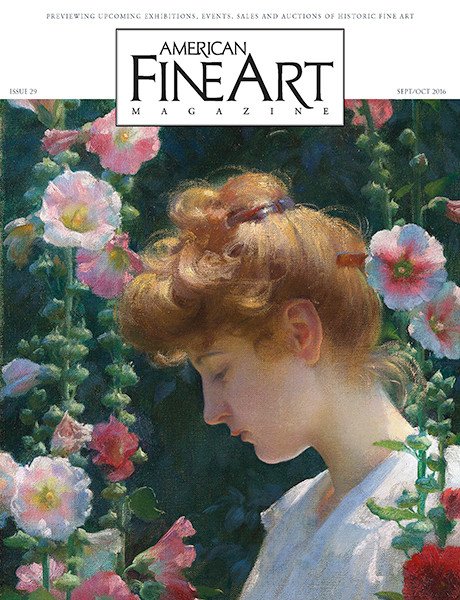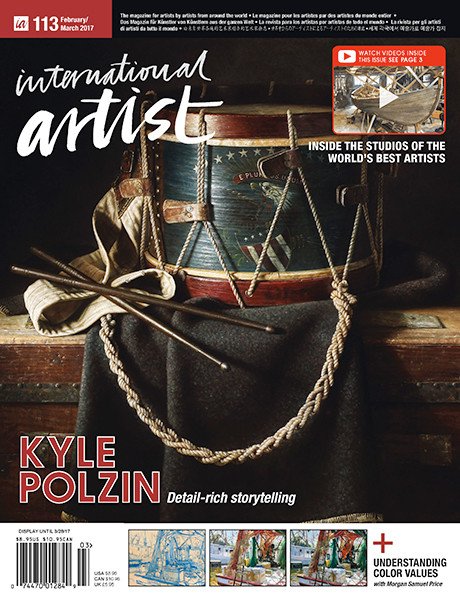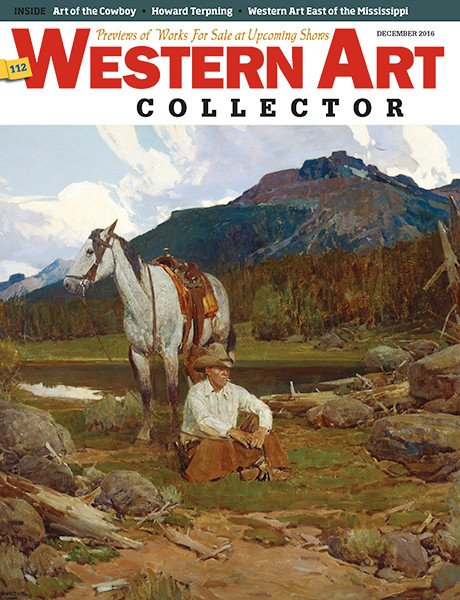Our collectors reveal that at one time they “didn’t have two nickels to rub together.” When they got married, they each had a nickel. Whenever they had two nickels again, they would buy a piece of art, primarily Plateau beadwork. They prospered and, after 37 years of marriage, have put together an important collection with the knowledge that comes from experience. Their friendships with artists, curators, professors and other collectors have enhanced that knowledge. Today, they are adept at identifying the tribes the pieces come from as well as their makers—if not by name, by their designs and technique. This is a skill developed by those who have, as the collector says, “looked at millions of pieces.”

Two Lakota adult vests and two Lakota children’s vests, 1890-1910, are displayed on the reading balcony. A Cheyenne cradle, ca. 1900, is to the left of the window. A Lakota beaded headstall, 1900, is displayed in one of the niches on the lower shelf. Southwest baskets and Santo Domingo pots by Vidal Aguilar complement the beadwork and hand-troweled walls. A painting by Billy Schenck, Liz at La Bajada, 1999, is on the top shelf.
In 2002, the couple attended the Whitehawk show in Sante Fe, New Mexico, where they admired a beaded doctor’s bag purse. “It was more expensive than we expected,” he relates, “but it was very beautiful. We walked around the show and kept coming back to see the bag, so we had to get it.”
In 2010 he found a postcard in an online auction that showed Susie Good, a beadmaker from Rosebud Reservation in South Dakota, holding the bag.

A Lakota beaded horse headstall, a Lakota dance cuff and Lakota moccasins, 1890-1910, are on the repurposed top section of a French pharmacy cabinet. Above it is a commissioned painting by Billy Schenck, Ground tied Horses in the Tetons, 2020. The view is from the collectors’ home in Jackson Hole, Wyoming.

A rare fully beaded Sicangu Lakota girls dress, 1890, hangs above a Roycroft Little Journeys book stand. On the stand area Lakota tipi bag, 1910, and Lakota child’s honor/parade moccasins, which are beaded on the bottom to be visible while riding horseback in a parade. Beneath them on the shelf are Lakota fully beaded parade stirrups. Iroquois moccasins, 1910, are on the bottom shelf.
In 2012, his wife found a vest with the same designs that belong to Susie Good in an online auction. She bought the “Susie Good Vest.” “The dye lots for the beads were the same as the ‘Susie Good Bag,’ so…we had to get it to reunite the two items from her hand,” he explains. “The designs and colors are unmistakably the same artist.”
He adds, “Each lady had her own designs. Shapes and designs were first made in a standard way. Later the ladies would begin to develop their own designs and adopt designs and techniques they had seen in the work of other bead workers and the designs evolved.”

A rare blue Lakota women’s saddle blanket, 1890-1905, is among three blankets on display in the stairwell. The collector notes that beaded saddle blankets were only used by women. The Sicangu Lakota painted box and border robe, 1890, is made on a longhorn cow hide. The collectors’ Texas home is a ranch that raises Texas longhorn cattle. The porcupine quilled pipe bag on the right is also made on longhorn hide. Two pair of Lakota beaded moccasins, 1890s, are on the countertop. On the shelves is a collection of Japanese Majolica assembled by the collector and her mother.

A Lakota leader’s shirt, 1890, hangs above an Arts and Crafts movement rocking chair on which is a Lakota tipi bag. In the foreground is a Santo Domingo pot with Iroquois moccasins and council pipe and a buffalo pipe stem section.
The story of the “Susie Good Vest” continued after their friend Emil Her Many Horses visited the ranch in 2013. Her Many Horses is an Oglala Lakota beadwork and quillwork artist and a curator at the National Museum of the American Indian. He saw the vest and two years later identified a man wearing it in a photograph from a celebration on Rosebud Reservation from more than 100 years earlier. “Somehow it all came together,” the collector says.
Beadwork had evolved among the Indigenous people of North America who had initially decorated their regalia with dyed porcupine quills, bone, shells, pebbles, coral, wood, elk teeth and semi-precious stones. Glass beads were introduced by Europeans in the 16th century, and early designs often copied those made with quills and other materials.

On the wall of the collectors’ guest house dining room are three Plateau horse flat bags, 1890-1920, above a Sicangu Lakota dentalium-shell cape that was featured on Antiques Roadshow. On the Gustave Stickley mission, eight-leg oak sideboard, 1905, are a Sioux little boy’s suit, 1920, with Lakota beaded moccasins by Charlene Holy Bear, 2015.

The great room of the ranch’s main house features a French stairwell, 1730s, and front doors from a French apartment, 1730s. The “lady of the house” purchased the Lakota saddle bags, 1890-1905, on the opening night of Morningstar Gallery’s famous saddle bag exhibition.
A Sicangu Lakota painted box and border robe in the collection was painted on a longhorn cow hide rather than the more common buffalo hide. The couple’s home is a Texas longhorn cattle ranch, one of whose steers is in the Guinness Book of World Records for the 11-foot span of its horns. “The historic connection of Texas Longhorn and Native Art is fascinating to us,” he says. “We have a porcupine quilled pipe bag that is also made on longhorn hide. In the 1890s, longhorn cattle were driven from Texas to feed the tribes and released on Beef Issue Day for Lakota people. We have photographs of the event in 1889 at the Rosebud Agency in South Dakota. I was adopted into the Rosebud tribe in a Hunkálowanpi (Making of Relatives) ceremony, one of their seven sacred rites.”
Occasionally, their discoveries are unexpected. They had collected the showy wooly chaps that cowboys on the Northern Plains wore for warmth in the winter. On a trip to Kansas they found a piece of beadwork that they later realized matched the contour of the top of the wooly chaps and was meant to go with them. Ten years later they found another beaded top.

On the desk of the husband’s office is a Sicangu Lakota fully beaded cradle, 1890. On the corner stand are a Lakota beaded saddle blanket, 1900, and a blue beaded Lakota saddle cover set, 1910. A group of Lakota bags, 1902, includes the pipe bag on the far right with a horse and woman rider motif, attributed to Nellie Gate. The vest on the drum table is by Dorothy Little Elk, 2004. The pipe bag with the blue beaded square, 1910, reads “Makpia Duta” (Red Cloud).

In the wife’s office is part of her collection of 60 Plateau horse imagery flat bags, 1900-1920 and part of her collection of Japanese Majolica.
In her office, there is part of her collection of 60 Plateau beaded flat bags with her favorite horse and cowboy motifs. There and throughout their home is her collection of Japanese majolica, which she assembled with the assistance of her mother.
Sometimes pieces have been brought into the collection for more of an aesthetic purpose. They chose Southwestern woven baskets and Santo Domingo pottery to go with the color of their hand-troweled walls. She wanted to be sure, however, that the Santo Domingo pots were by the same artist which, in this case, is Vidal Aguilar.

The collection of Lakota dolls, 1990-2010, was made by Dorthy Little Elk on the far left, Charlene and Rhonda Holy Bear in the middle and, on the far right, Emil Her Many Horses. On the counter is a pair of beaded cowboy boots, 2019, by Jerimiah Holy Bull. On the wood shelves is a collection of Lakota beaded bags focused on the 1890s and a group of Lakota art deco beaded purses, ca. 1920s and 1930s. On the top shelves, above the Emil Her Many Horses dolls are two pairs of beaded “Mary Jane” moccasins. To the left on the bottom shelf of the glass case is a vest with a flag motif and the beaded inscription: “Dick Red Bear, 4th of July 1903.” In the middle of the shelf is a Sicangu Lakota vest and doctor’s bag purse beaded by Susie Good, 1904 and 1906.

Susie Good, Rosebud Reservation beadmaker, holding her doctor’s bag purse now in the couple’s collection.
He enjoys waking up in the morning and gazing at the 1890, rare, fully beaded Sicangu Lakota girl’s dress. “I think about how much love they must have had for that little girl,” he says. “She would have outgrown the dress in a year. An interesting thing happened when Francis Smith photographed the dress with his bright lights. We could see where the woman had run out of the blue beads she had been using and had to finish up with beads from another lot. In natural light they all look alike.”
As they have learned the designs and techniques of various tribes and individual artists, they have discovered the influence of worldwide design trends on Native work. “Our Lakota beaded bag collection is focused on the 1890s,” he explains, “but we also have a grouping of 1920s and ’30s art deco Lakota beaded purses. As art deco roared through the non-Native world, it roared through the Native world. On the shelves in the study, above the Emil Her Many Horses dolls, you can see two pairs of ‘Mary Jane’ moccasins.” Mary Janes were popular shoes from early in the 20th century, especially in the ’20s and ’30s. They are characterized by their rounded toes and T-straps—think Shirley Temple.

The Texas Longhorn herd at the collectors’ ranch house.

In the nicho is a rare Lakota bead teen boy’s suit, 1905, a small Lakota boy’s pipe bag, 1890. On the right is a Lakota man’s hair ornament, 1905.
Both collectors enjoy rediscovering pieces in their vast collection, walking around a corner and looking up at a piece to admire how the design works and how the colors go together. “I enjoy being around it,” he says. “It intrigues me wondering where has it been, who did it belong to, was it made for a special occasion? It never gets old as we always discover something new.”
He recalls visiting their friend Alan Hirschfield and his eminent collection. Gaylord Torrence, former curator of Native American art at the Nelson-Atkins Museum of Art in Kansas City, Missouri, described it as “among the greatest private collections of Plains and Plateau Indian art in the world.”
Alan told us, “You can never have too much beadwork.” —
Powered by Froala Editor











































